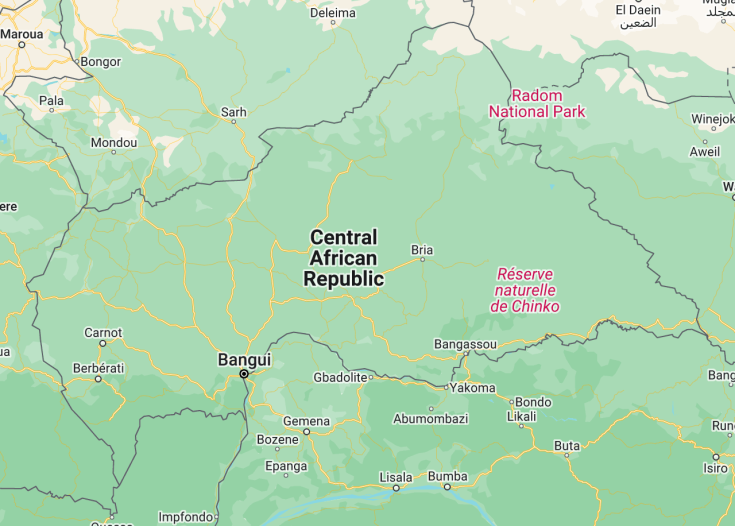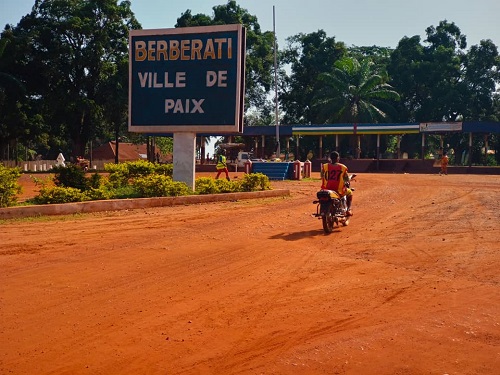Central African Republic (CAR), a jewel in the heart of Africa, is an untamed wonderland, resplendent with dense rainforests, meandering rivers, and a tapestry of diverse cultures. With its turbulent history, CAR is a destination where nature’s grandeur and human resilience shine in harmony.
For a genuine experience, consider hiring local guides. Their insights can unravel the layered stories of the land and its people.
While the urban areas have amenities, venturing inland requires preparation. Ensure vaccinations and travel insurance are up-to-date.
How to best experience Central African Republic?
Search for Tickets, tours, and activities in Central African Republic using direct search on the following providers:
GetYourGuide.com Viator.com Trip.com Expedia.com Tiqets.com Ctrip.com (中文)
Top cities to visit in Central African Republic
Discover the best cities of Central African Republic and best places to visit.
Central African Republic: Unravel the Beauty of the Heart of Africa
| Capital | Bangui |
| Time in Central African Republic | GMT+1 |
| Language spoken | French, Sango |
| Population | 4.7 million (World Bank, 2021) |
| Religion | Christianity (80%) Islam (15%) Traditional African religions (5%) |
| Currency | Central African CFA franc (₣, XAF) |
| Airports | Bangui M’Poko International Airport Berberati Airport |
The Central African Republic, often abbreviated as CAR, stands as a testament to Africa’s rich tapestry of cultures, traditions, and landscapes. Located in the heart of the continent, this nation boasts vast savannahs, dense forests, and a tapestry of rivers, making it a haven for diverse wildlife. The story of the Central African Republic is a compelling one; from its pre-colonial kingdoms and empires, such as the powerful Baya and Banda, through to its period under French colonial rule, and its eventual journey to independence in 1960. Throughout its history, the people of CAR have shown resilience and adaptability, preserving their diverse cultures and traditions amidst the challenges. The nation, rich in resources like diamonds, gold, and timber, has often been at the nexus of economic and political interests, leading to multifaceted geopolitical dynamics. Despite facing periods of conflict and unrest, the spirit of the Central African people remains unbroken. They continue to move forward, looking to a future that pays homage to their past while embracing the promise of tomorrow. For those intrigued by untold stories and uncharted landscapes, the Central African Republic offers a deep dive into the very essence of Africa, blending history, culture, and natural beauty in a symphony of experiences.
Where is Central African Republic located?
The Central African Republic is located in the heart of Africa, bordered by Chad to the north, Sudan to the northeast, South Sudan to the east, the Democratic Republic of the Congo and the Republic of the Congo to the south, and Cameroon to the west. Its central location makes it an accessible destination for those seeking to explore the African continent.
What is Central African Republic famous for?
The Central African Republic is famous for its diverse wildlife and stunning natural landscapes. It is home to several national parks, including Bamingui-Bangoran National Park and Manovo-Gounda St. Floris National Park, which are renowned for their rich biodiversity and offer opportunities for wildlife safaris and eco-tourism. The country is also known for its vibrant arts and crafts scene, with artisans creating intricate wood carvings, colorful textiles, and unique pottery.
History
Prehistoric Era: Early Settlers
The history of the Central African Republic (CAR) is as rich as it is varied. Archaeological evidence suggests that humans have lived in the territory for thousands of years, with traces of civilization stretching back to the Neolithic era. The vast expanse of the CAR made it a melting pot for different tribes and cultures. The Baya and Banda people, among the major ethnic groups, migrated to the region during the 14th and 18th centuries respectively, establishing their communities.
19th Century: Arrival of European Explorers
European contact with the CAR began in the late 19th century. As European powers explored and sought control over Africa, the region was penetrated by French explorers. Initially, they established trade relationships, primarily for ivory and slaves, which led to the establishment of forts and trading posts.
1894-1960: French Colonial Rule
In 1894, the area was formally declared a French protectorate and became part of French Equatorial Africa in 1910. The French administrative system influenced various aspects of CAR’s life, from education and religion to politics and the economy. Despite infrastructural development, the colonial period was marred by forced labor, especially in the timber and rubber industries. It wasn’t until 1946 that the CAR saw its first elected representative to the French National Assembly.
1960-1979: Independence and the Bokassa Era
On August 13, 1960, the Central African Republic achieved independence from France. David Dacko, a leading political figure, became the nation’s first president. However, his rule was short-lived, as Jean-Bédel Bokassa overthrew him in a 1965 coup. Bokassa’s reign was marked by increasing authoritarianism. In 1976, he declared himself emperor and renamed the country the Central African Empire. His opulent coronation in 1977, amidst a period of economic downturn and political repression, drew international ire. By 1979, facing mounting pressure, Bokassa was overthrown, and the country reverted to its previous name.
1980-Present: Turbulence and Hope
The years following Bokassa’s overthrow were marked by political instability, with multiple coups and a shifting landscape of power. Ange-Félix Patassé came to power in 1993 and his tenure was characterized by economic decline and unrest. In 2003, Patassé was ousted by François Bozizé, whose rule saw the intensification of ethnic and religious conflicts. The last two decades have been marred by ongoing civil conflicts, often fueled by ethnic and religious divisions, particularly between the Muslim Séléka rebel coalition and the Christian anti-Balaka militias. International interventions and peace deals have intermittently stabilized the situation, but sustainable peace remains elusive. Despite these challenges, the people of the Central African Republic remain hopeful and resilient, continuously striving to build a brighter future for their nation.
Visit Central African Republic
What to see and do in Central African Republic
Central African Republic offers visitors a unique blend of natural beauty and cultural heritage. There are several attractions and activities that can be enjoyed in the city:
- Explore the stunning landscapes of Manovo-Gounda St. Floris National Park, which is a UNESCO World Heritage Site.
- Visit the Presidential Palace, a symbol of the country’s political history and architectural grandeur.
- Discover the vibrant local markets, where you can find traditional crafts, spices, and fresh produce.
- Immerse yourself in the rich cultural traditions of the local tribes, such as the Bayaka and Banda people.
Events in Central African Republic
Central African Republic hosts several cultural and religious events throughout the year, offering visitors a chance to experience the local traditions and festivities:
- The National Day of Central African Republic is celebrated on {date} and is marked by parades, music, and cultural performances.
- The Bangui Fashion Week showcases the vibrant fashion industry of the country and attracts designers and fashion enthusiasts from around the world.
- The Festival de Boganda is a music festival held in honor of Barthélemy Boganda, the country’s first president.
Best time to visit Central African Republic
The best time to visit Central African Republic is during the dry season, which typically runs from December to March. During this time, the weather is mild, and there is less rainfall, making it easier to explore the city and its surrounding natural areas. It is important to note that the country still faces security challenges, and it is advisable to check the travel advisories and consult local authorities before planning a trip.
Is Central African Republic worth visiting?
Central African Republic has a rich cultural heritage and stunning natural landscapes that make it an intriguing destination for adventurous travelers. However, it is important to consider the current security situation and the challenges the country faces. Tourists should exercise caution and stay informed about the latest travel advisories before planning a trip. While it may not be suitable for all travelers, those seeking unique experiences and a deeper understanding of the region’s history and culture may find Central African Republic worth exploring.
Common questions
What are the popular attractions in Central African Republic?
- Goroumbwa-Monjalou National Park
- Dzanga-Sangha Protected Areas
- Bamingui-Bangoran National Park
- Manovo-Gounda St Floris National Park
- Odzala-Kokoua National Park
- Zemongo Faunal Reserve
What are the best wildlife viewing spots in Central African Republic?
- Dzanga-Bai: This large clearing attracts a variety of wildlife, including elephants, gorillas, and forest buffalos.
- Manovo-Gounda St Floris National Park: Home to elephants, leopards, lions, and numerous bird species.
- Chinko Project Area: A vast conservation space with diverse wildlife, including elephants, giraffes, and antelopes.
What are the traditional dishes to try in Central African Republic?
- Poulet Nyembwe: Chicken cooked in palm oil and served with cassava or plantains.
- Brochettes: Skewered meat (commonly beef or goat) grilled over open fire.
- Bangui-style spinach: A vegetarian dish made with spinach, peanut butter, fresh tomatoes, and spices.
What is the climate like in Central African Republic?
Is it safe to travel to Central African Republic?
What languages are spoken in Central African Republic?
Are there any special customs or etiquette to be aware of in Central African Republic?
- Greetings: It is customary to greet people with a handshake and a smile. Use the right hand for greetings and avoid pointing with it.
- Respect for elders: Show respect to older individuals by using appropriate titles and gestures.
- Dress modestly: When visiting rural areas or religious sites, it is advised to dress modestly and avoid revealing clothing.
- Photography: Always ask for permission before taking someone’s photograph.
What is the currency used in Central African Republic?
What is the best time to visit Central African Republic?
What vaccinations do I need before traveling to Central African Republic?
- Yellow fever
- Typhoid
- Hepatitis A and B
- Meningitis
- Rabies (if you are planning close contact with animals)




